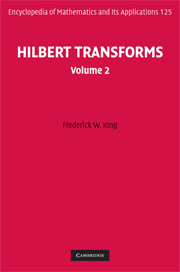Book contents
- Frontmatter
- Contents
- Preface
- List of symbols
- List of abbreviations
- 15 Hilbert transforms in En
- 16 Some further extensions of the classical Hilbert transform
- 17 Linear systems and causality
- 18 The Hilbert transform of waveforms and signal processing
- 19 Kramers–Kronig relations
- 20 Dispersion relations for some linear optical properties
- 21 Dispersion relations for magneto-optical and natural optical activity
- 22 Dispersion relations for nonlinear optical properties
- 23 Some further applications of Hilbert transforms
- Appendix 1 Table of selected Hilbert transforms
- Appendix 2 Atlas of selected Hilbert transform pairs
- References
- Author index
- Subject index
20 - Dispersion relations for some linear optical properties
Published online by Cambridge University Press: 06 July 2010
- Frontmatter
- Contents
- Preface
- List of symbols
- List of abbreviations
- 15 Hilbert transforms in En
- 16 Some further extensions of the classical Hilbert transform
- 17 Linear systems and causality
- 18 The Hilbert transform of waveforms and signal processing
- 19 Kramers–Kronig relations
- 20 Dispersion relations for some linear optical properties
- 21 Dispersion relations for magneto-optical and natural optical activity
- 22 Dispersion relations for nonlinear optical properties
- 23 Some further applications of Hilbert transforms
- Appendix 1 Table of selected Hilbert transforms
- Appendix 2 Atlas of selected Hilbert transform pairs
- References
- Author index
- Subject index
Summary
Introduction
The developments of the previous chapter are continued in this chapter. The principal focus is on the reflectance and the energy loss function. Knowledge of the reflectance and phase allows the real and imaginary parts of the complex refractive index to be evaluated, and hence the real and imaginary parts of the complex dielectric constant can be determined. Measurement of the reflectance and calculation of the phase provides a convenient route to a number of optical properties.
The procedure for dealing with the formulation of dispersion relations for the reflectance and phase has some features that are different from the cases of the dielectric constant and the refractive index. This is tied directly to the fact that the real and imaginary parts of the complex reflectivity depend upon both the reflectance and the phase. To uncouple these quantities requires consideration of the logarithm of the complex reflectivity, which introduces some additional issues into the discussion. This also has a direct bearing on the types of sum rules that can be derived.
Dispersion relations for the normal-incident reflectance and phase
The topic of obtaining dispersion relations for the normal-incident reflectivity is examined in this section. Consideration is restricted to the normal-incidence case, and it will be assumed that light is impinging on the material surface from a vacuum. The reflectivity, R(ω), is the ratio of the reflected to the incident light intensities.
Information
- Type
- Chapter
- Information
- Hilbert Transforms , pp. 252 - 305Publisher: Cambridge University PressPrint publication year: 2009
